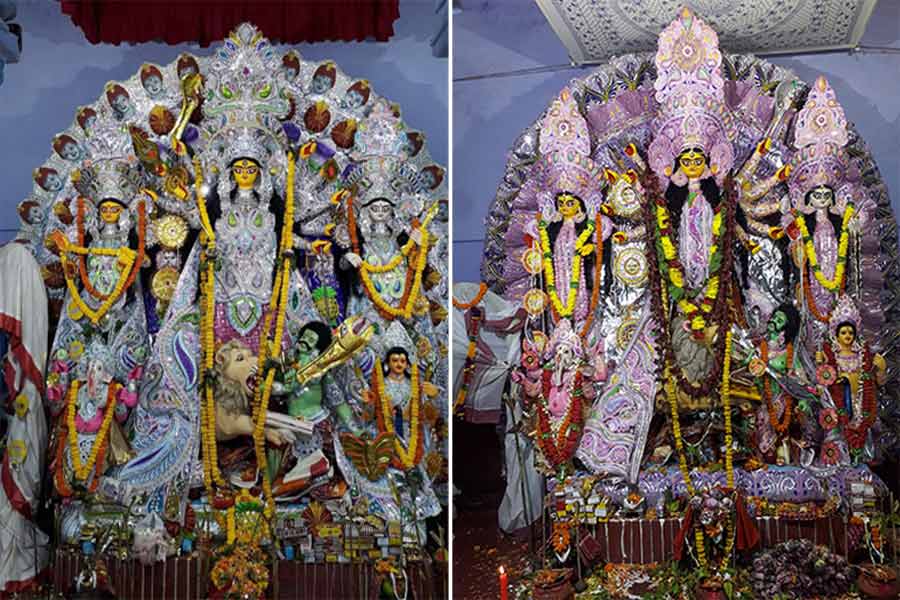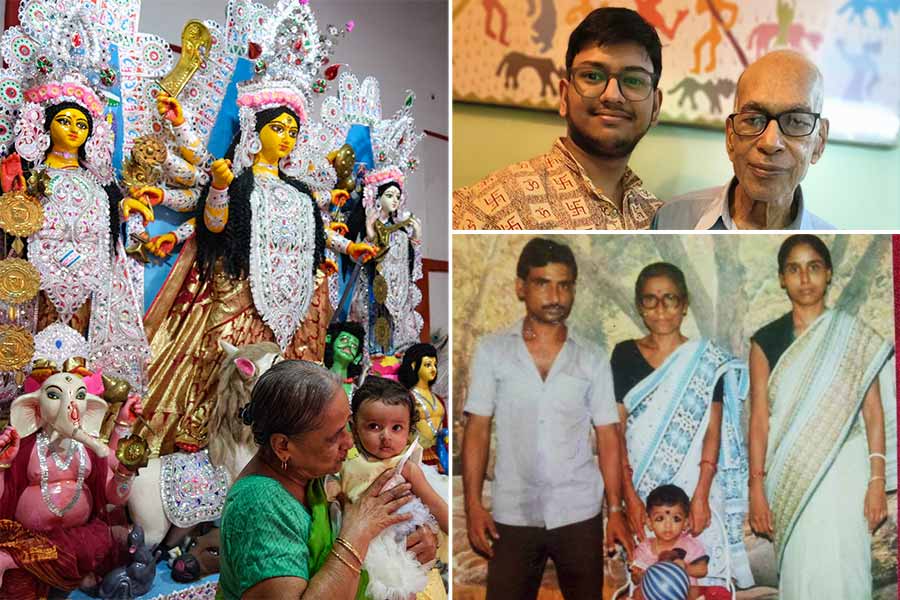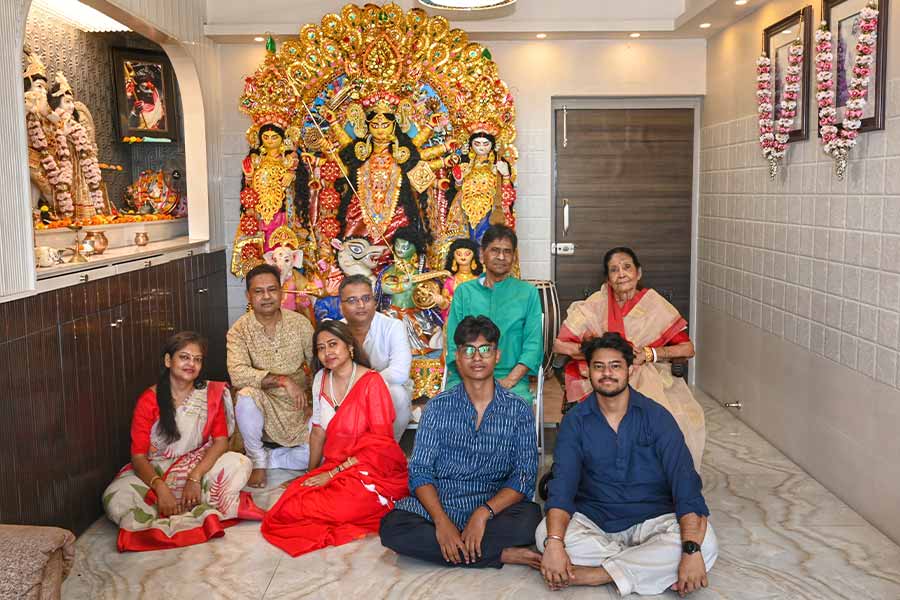Exactly how old is the Durga Puja of Pal family at Ranaghat in Nadia district? That was my first question to Dilip Paul, a senior member of the family aged around 70, who lives in the palatial Pal house at Ranaghat in Nadia district. Located in Biswaspara, close to Ranaghat Sporting Club stands a two-storeyed mansion studded with Corinthian pillars and two lion statues facing each other on their top. A portion of the house has been modified in recent times. Yet, the house looks more imposing than any other traditional house in Ranaghat.

The grand mansion of the Pal family at Ranaghat was built by Lal Gopal Paul in 1900
The house was built sometime around 1900 by Lal Gopal Pal, Dilip’s great-grandfather. Before that, a smaller house stood at the same spot. Durga puja was started by Lal Gopal Pal in that small house sometime in the late-19th century. Thus, the Durga puja conducted in this house would be around 150 years or so. Whether a Durga puja was conducted by Lal Gopal Pal’s father, Gopeshwar or his other ancestors before that is unknown.
What is known, however, is Lal Gopal Pal hailed from an extremely poor family of potters. The family originally belonged to Dignagar, Nadia.
Owing to lack of financial support from his father, Lal Gopal Pal was forced to leave his education after studying up to Class V and take employment in a grocery shop at a salary of one anna. His employer was satisfied with his work and helped him start a business of clothes and groceries. Despite a setback, he fought back and built a large business and acquired many lands and properties. Ultimately, he built this mansion and even a school in Ranaghat in 1926. The family has a Shiva temple where the deity is worshipped daily. The Pals have a debottar trust, which takes care of the total expenses of Durga Puja.
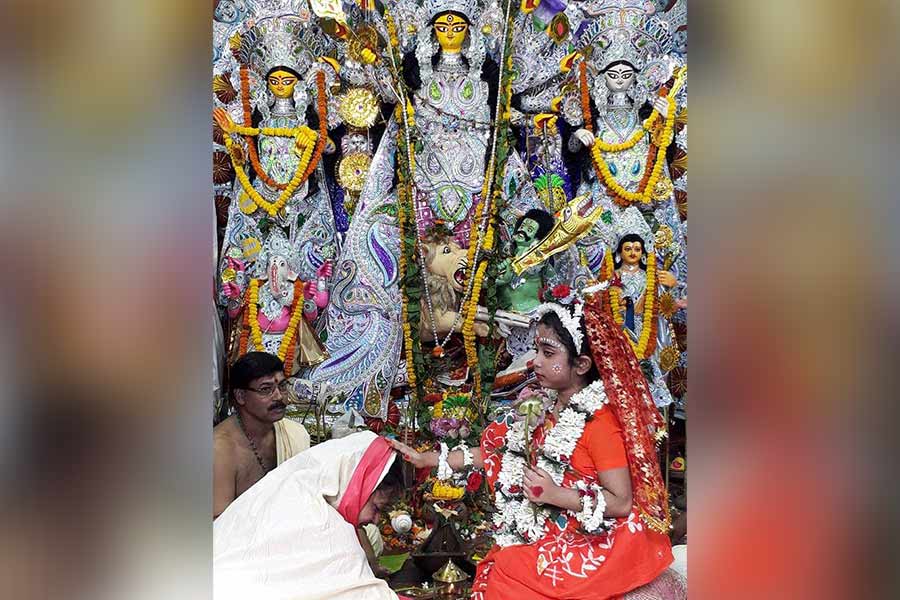
Kumari Puja at the Ranaghat Pal family residence takes place on Ashtami
At present, the Pal family has four shariks or four families who take turns in organising the puja by rotation ever year. The design of the deities remains the same and the goddess is decked out in multi-coloured foil (rangta) and embellished with silver sequins, popularly known as daaker saaj. Every year, the organising family changes the colour of the foil. So, it may be green in one year and white or pink another year.
The goddess is not adorned with any gold or silver jewellery but the weapons of the deities are made of brass plated with nickel.

The ‘thakur dalan’ of the Ranaghat Pal family
The artisans making the Durga idols for the family have been doing so over the past few generations. Also, the same family of dhakis has been performing for the family for several years. However, the descendants of the priests who earlier conducted pujas for the Pal family have discontinued their profession. Thus, for the last 15 years, the Durga Puja of the Pal family has been conducted by a different priest.
Kathamo puja of the Pal family takes place on the day of Rath Yatra. Bodhon (awakening) of the goddess takes place on Sashthi. Navapatrika rituals of the Pal family are a private affair and are conducted on the thakur dalan itself.

There are two types of rice offering with raw vegetables and spices to the goddess
Food offering to the goddess in the morning comprises aatap chal (sunned rice) uncooked pulses, raw vegetables cut into pieces smeared with turmeric, betel leaf with a supari, narkel naru, papad, rock salt, cooking oil and several spices used for cooking, on eight to 10 plates. The second type is more or less the same except two differences. Here, the rice used is uncooked seddho chaal (parbolied rice) and the raw vegetables are offered uncut. With these offerings, an earthen pot and fire wood are also provided as if the goddess is going to cook these ingredients for her consumption.
After completion of puja every day, these offerings are sent to the houses of Brahmins. They are offered to the Brahmin priest who conducts the puja as well. The offerings are sent four times, that is after completion of puja on Saptami, Ashtami, Navami and Sandhi Puja.
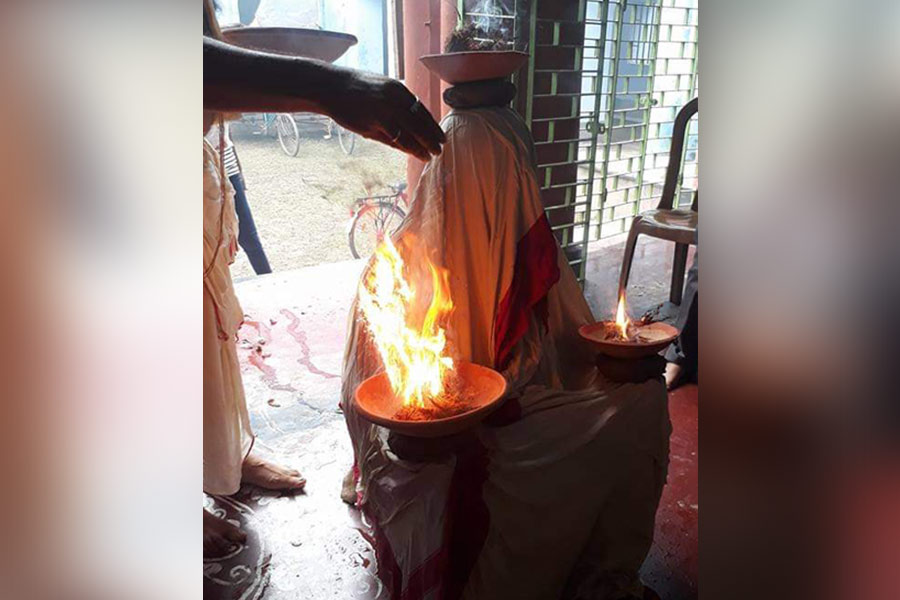
The lady of the house who performs ‘dhuno purano’ rituals sits with a long veil
This arrangement of sending food offerings to Brahmins from a house which was built by the son of a potter, who amassed his wealth from scratch may remind some old-timers of a similar character from Bibhutibhushan Bandyopadhay’s epic novel Ichamati. The character was Lal Mohan Pal, who once had barely any decent meal, becomes a big businessman and sponsors a grand feast for Brahmins of the village.
The food offering in the evening to the goddess is grand. A combination of luchis with chhana, rosogolla, cashew nuts, raisins, pistachios and almonds are offered to the goddess in 16 portions, with each portion having four luchis along with other items in equal proportions. So, in total, 64 pieces of luchis are served to the goddess.

The 108 lamps during Sandhi Puja at the Ranaghat Pal family residence are arranged in a rectangular shape
During Sandhi Puja, the women of the house light 108 earthen lamps placed on banana leaves and arrange them in a rectangular shape. There is no animal sacrifice in the puja of the Pal family; only sugercane, white gourd and cucumber are sacrificed.
On Ashtami, Kumari Puja takes place with a solitary Kumari. Dhuno purano (lac burning) rituals take place on Navami but there are slight differences in the style. There is a senior woman family member who performs the rituals with three earthen containers with flames glowing on them as fire is set on dhuno (aromatic lac used in Hindu religious occasions). The unique thing is that she covers her face in a ghomta as a veil so that her face is not visible. Also, the woman comes wearing a wet sari, a precautionary measure against the flames. Sometimes, she sits with a child on her lap. After the dhuno purano rituals, a hom yajna is performed.
There is another interesting ritual which happens on Navami at the Pal residence in Ranaghat. After the Navami puja is over, the youngsters of the house along with some dhakis visit eminent houses nearby who are also celebrating Durga puja over a long time. Similarly, youngsters from these houses visit the Pal residence. Then, they indulge in a practice known as kada khela or playing with mud. Earlier, youngsters used to literally roll in mud but in the present day, the ritual has been limited to putting a mud tilak on each other’s forehead.
After darpan bisarjan and dadhi karma rituals, the boron ritual of the goddess takes place followed by sindoor khela.
Earlier on Dashami, the goddess used to be carried manually and ultimately, the immersion was made from a boat. However, that practice has stopped and the deity is taken for immersion in a vehicle to the nearby Churni river.
